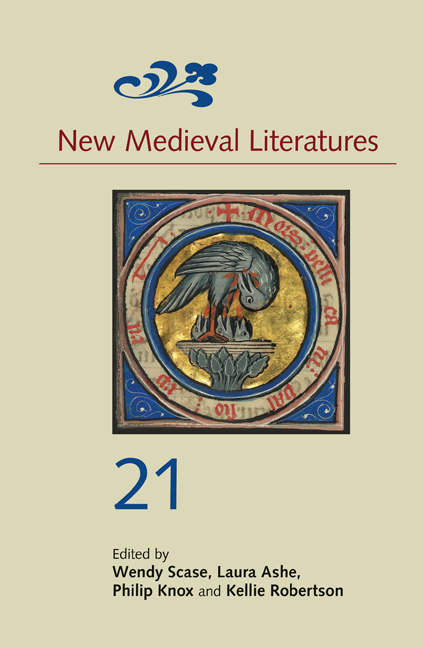Book contents
- Frontmatter
- Contents
- List of Illustrations
- List of Abbreviations
- 1 ‘Chevaliers estre deüsiez’: Genealogy and Historical Sense in Chrétien de Troyes’s Conte du Graal
- 2 English Vernacular Script in the Thirteenth Century (c.1175–c.1325)
- 3 The Manuscript as Agent: The Politics of London, British Library, Additional MS 15268 (Histoire ancienne jusqu’à César)
- 4 Repetition, Craft-Knowledge, and Richard Rolle’s Creaturely Sublime
- 5 Truth-Telling and Truthiness in the Middle English Popular Romances
- 6 Assaying the Deer Drive in Sir Gawain and the Green Knight
- 7 The Past of the Past: Historical Distance and the Medieval Image
1 - ‘Chevaliers estre deüsiez’: Genealogy and Historical Sense in Chrétien de Troyes’s Conte du Graal
Published online by Cambridge University Press: 13 April 2021
- Frontmatter
- Contents
- List of Illustrations
- List of Abbreviations
- 1 ‘Chevaliers estre deüsiez’: Genealogy and Historical Sense in Chrétien de Troyes’s Conte du Graal
- 2 English Vernacular Script in the Thirteenth Century (c.1175–c.1325)
- 3 The Manuscript as Agent: The Politics of London, British Library, Additional MS 15268 (Histoire ancienne jusqu’à César)
- 4 Repetition, Craft-Knowledge, and Richard Rolle’s Creaturely Sublime
- 5 Truth-Telling and Truthiness in the Middle English Popular Romances
- 6 Assaying the Deer Drive in Sir Gawain and the Green Knight
- 7 The Past of the Past: Historical Distance and the Medieval Image
Summary
Chrétien de Troyes's twelfth-century romance Le Conte du Graal, also called Perceval, or The Story of the Grail, opens as a young, nameless boy stands in a clearing with his javelin. In the distance he hears the terrifying din of a group of knights approaching. He is afraid at first, but then, as they emerge from the woods, he is struck by their beauty:
Et quant il les vit en apert
Que do bois furent descovert,
Si vit les hauberz fremïenz
Et les hiaumes clerz et luisanz
Et vit lo vert et lo vermoil
Reluire contre lo soloil
Et l’or et l’azur et l’argent,
Si li fu molt tres bel et gent.
(And when he saw those who had been hidden by the woods out in the open, when he saw their hauberks trembling and their bright and shining helmets, and he saw the green and the vermilion resplendent in the sun and the gold and the azure and the silver, then they seemed very handsome and noble.)
This description wouldn't seem out of place in a nineteenth-century story, like Sir Walter Scott's Ivanhoe, or in more contemporary productions, like the musical Camelot, or the 1995 film First Knight. In the collective imagination, knights are beautiful, perfect, and free of any real moral failings (aside from the kind that stem from the truest, deepest, albeit forbidden love). Even so, it is readily apparent from the earliest of Chrétien's romances that the vision of the perfect knight rests on crumbling foundations; as early as Erec and Enide, the otherwise exemplary Erec is, following his marriage, accused of being recreanz (weak or cowardly) before having to be set once more on the correct path. The Conte du Graal forms a trilogy of sorts with Yvain, Le Chevalier au lion (The Knight of the Lion) and Lancelot, Le Chevalier de la charrette (The Knight of the Cart). Like Lancelot and Yvain, whose stories are centered around a quest for redemption, Perceval's is also one of education and discovery, as well as of fulfilling destiny. It is also unfinished; the last romance of Chrétien's Arthurian world and the beginning of a series of continuations by other authors. As such, it exists in a narrative interstice between Chrétien's first ventures and what would become the flourishing and long-lived mythology of King Arthur and his Knights of the Round Table.
- Type
- Chapter
- Information
- New Medieval Literatures 21 , pp. 1 - 27Publisher: Boydell & BrewerPrint publication year: 2021



